This is the website of Abulsme Noibatno Itramne (also known as Sam Minter).
Posts here are rare these days. For current stuff, follow me on Mastodon
|
You may have heard all the breathless coverage last night of Sanders’ surprise win in Michigan. And it was indeed a surprise. He outperformed all the recent polls by a substantial margin. This was a big huge win, right?
Well, no. It wasn’t. The media hype is all around the fact that it is more interesting to cover an actual race than a slow march to an almost inevitable win. Time to look at the numbers.
First of all, the straight up delegates out of Michigan: Sanders 69, Clinton 61
That means Sanders got 53.1% of the Michigan delegates. To be on a pace to catch up and win, he needed 60.2% of the delegates. He may have “won”, but he didn’t win by anywhere near enough to actually catch up with Clinton.
But Michigan wasn’t the only state handing out delegates. Mississippi did too. And Mississippi went for Clinton 32 to 4. So the total for the day was actually Clinton 93 to Sanders 73.
There were also some superdelegate updates since my last post. Net change: Clinton +4, Sanders +3.
So total since the Maine results on Sunday: Clinton 97, Sanders 76.
So Sanders only got 43.9% of the delegates since Sunday. This is not close to 60.2%.
Yes, Sanders pulled out a surprise win in Michigan. But he could duplicate that win in EVERY STATE from here until the end of the primary season and he STILL would not catch up. He would not win. He can’t catch up by “just winning”. He needs to win by huge margins to catch up. That did happen (barely) in Maine. But Michigan didn’t do it, and Sanders has only very rarely managed the margins he would need to catch up.
So, looking at the graph of “% of remaining needed to win”:
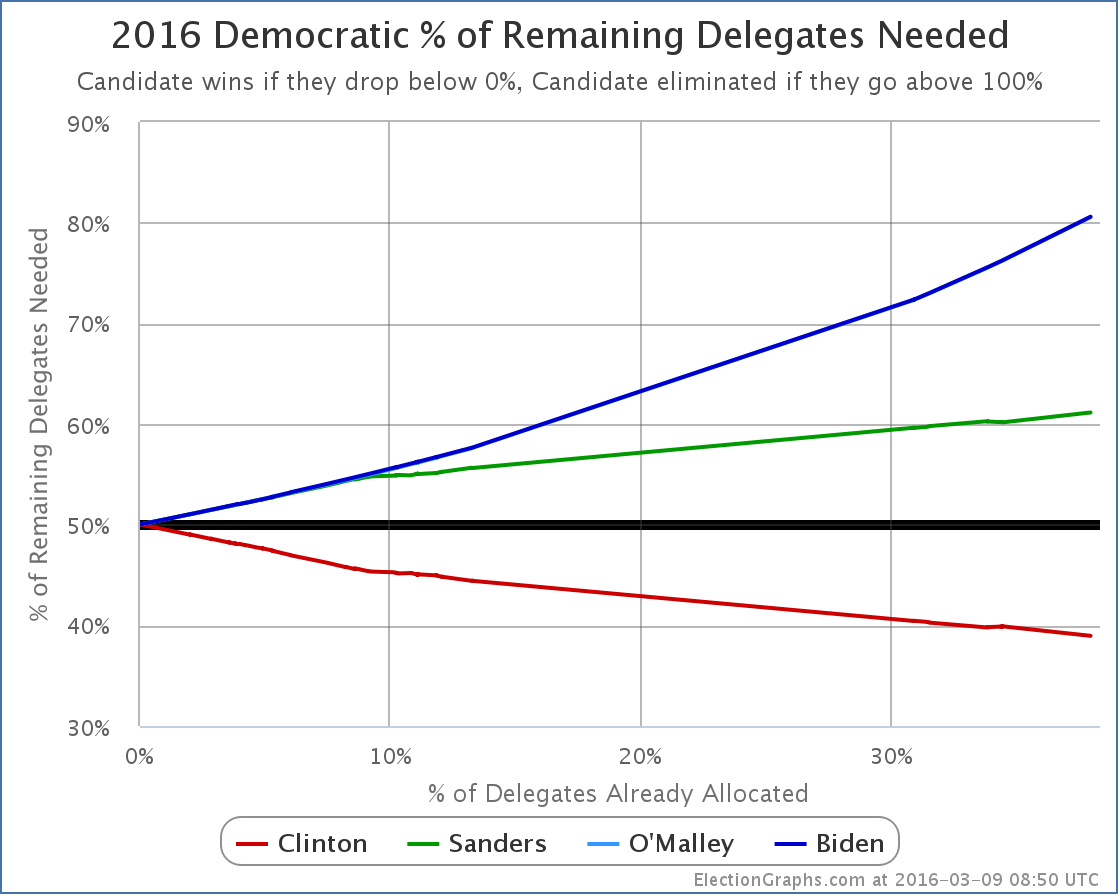
Clinton now needs 38.96% of the remaining delegates to win. Sanders needs 61.14% of the remaining delegates to catch up.
Oh, unless the superdelegates start changing their minds in massive numbers. That would make things harder for Clinton and easier for Sanders. And to be fair, if all 460 of Clinton’s superdelegates flipped to Sanders tomorrow, Sanders would indeed be ahead by 1035 delegates to 771.
I wouldn’t hold my breath on that one though.
Right now the totals are Clinton 1231, Sanders 575.
Next up are the Northern Marianas on Saturday, then Florida, Illinois, Missouri, North Carolina and Ohio next Tuesday.
[Edit 16:22 UTC to add the following exchange]
Minutes after I posted this update, I got a comment via Facebook that prompted me to do some additional analysis. It seemed directly relevant and interesting, so adding it here (lightly edited):
Jenn: Since superdelegates have never actually gone against the popular vote and could change their minds, what’s the math if we simply exclude them? I’m not saying it’ll happen. I’m just curious and too lazy to do it myself.
Sam: On superdelegates, my position is that if they ever start to change their minds because of the results of the pledged delegate race, we will see that because they will say so. So speculating about them changing their minds is pointless, you can actually watch and see if they do. If they start changing their minds, then it is a real thing and it will be measured and tracked as it happens. So long as they don’t, it is just a fantasy. But OK, I’ll quickly do the calculation of what things would look like if you only look at pledged delegates and assume superdelegates will follow the pledged delegate result.
[Edit 2016-03-10 16:07 UTC to strike through the calculation below due to really bad stupid math error that completely invalidates the result. Sanders needed percentage will be closer to 55%. Redoing calculations shortly.]
Sam: OK. Here goes. The current totals are Clinton 1231, Sanders 575, O’Malley 1. If you take out supers, that becomes Clinton 771, Sanders 552. Now, there are 2472 delegates total, so you need 1237 delegates to win. But that includes superdelegates. If the assumption is that supers will go for the pledged delegate winner, then you shouldn’t count them in the total number of delegates either because they now don’t matter. Without supers there are 1755 delegates, and you need 878 to win. Sanders therefore needs 326 more delegates to catch up and win. Between Clinton and Sanders they have collected 1323 delegates already. So there are only 432 pledged delegates remaining. 326/432 = 75.5%. So if you look only at pledged delegates it is actually WORSE for Sanders. He needs nearly 76% of the remaining delegates to catch up and win rather than “only” 61%.
[Edit 2016-03-10 17:30 to add additional conversation correcting the erroneous calculation. I am leaving the first version struck out above for the record. The below is lightly edited from the original Facebook conversation.]
Sam: Urg!!!! I made a huge error on those calculations! I blame it on…. Uh…. Being stupid. I used the total number of Republican delegates in one part of the calculation rather than the Democratic totals, which of course invalidates the whole thing. I suspect Sanders actually needs closer to 55% if you don’t count supers. I will redo the calculation.
Sam: OK, here goes again. I suck. Numbers that have changed bolded. The current totals are Clinton 1231, Sanders 575, O’Malley 1. If you take out supers, that becomes Clinton 771, Sanders 552. Now, there are 4765 delegates total, so you need 2383 delegates to win. But that includes superdelegates. If the assumption is that supers will go for the pledged delegate winner, then you shouldn’t count them in the total number of delegates either. Without supers there are 4048 delegates, and you need 2025 to win. Sanders therefore needs 1450 more delegates to catch up and win. Between Clinton and Sanders they have collected 1323 delegates already. So there are only 2725 pledged delegates remaining. 1450/2725 = 53.2%. This is significantly better than the 41.7% of pledged delegates Sanders has gotten so far, but it is not yet in the impossible zone by a long shot, and it is still better than where he is when you include superdelegates. Apologies for the stupid error.
Sam: I had actually checked and rechecked the calculation several times before posting it originally, but I made the same mistake every time. Sigh! Oh well!
Sam: See also this article by Andrew Prokop for more on what would be involved in a Sanders comeback. It was while reading this that I realized my error.
[Update 2016-03-10 06:45 UTC – Update in Michigan shifts 2 additional delegates from Sanders to Clinton. This does not substantially change the analysis above. In addition, the number of total “unpledged PLEOs” was adjusted in several states, giving a net addition of 1 total convention delegate.]
[Update 2016-03-11 05:29 UTC – Superdelegate update: Clinton loses one as a second superdelegate says they will just vote for the pledged delegate winner, putting them back in the uncommitted category for now.]
[Update 2016-03-12 23:50 UTC – Superdelegate update to prepare for March 12th results: Clinton +1, Sanders +1]
Note: This post is an update based on the data on ElectionGraphs.com. Election Graphs tracks both a poll based estimate of the Electoral College and a numbers based look at the Delegate Races. All of the charts and graphs seen in this post are from that site. Additional graphs, charts and raw data can be found there. All charts above are clickable to go to the current version of the detail page the chart is from, which may contain more up to date information than the snapshots on this page, which were current as of the time of this post. Follow @ElectionGraphs on Twitter or like Election Graphs on Facebook to see announcements of updates or to join the conversation. For those interested in individual general election poll updates, follow @ElecCollPolls on Twitter for all the polls as they are added.
[Edit 15:59 to fix one place I said Sanders instead of Clinton. Fixed. Thanks Jenn for pointing it out.]
[Edit 2016-03-10 21:12 UTC to fix author of Vox article I linked to.]
Sanders won Maine 16 delegates to 9 for Clinton.
In addition, further updates to Louisiana since yesterday gave Sanders 2 more delegates and Clinton 2 less.
So effectively, as 25 new delegates were added, Sanders increased his total by 18. So 72%. Way more than the 60.26% I said he needed to be on track to catch up and win. So how does that look on the big chart?
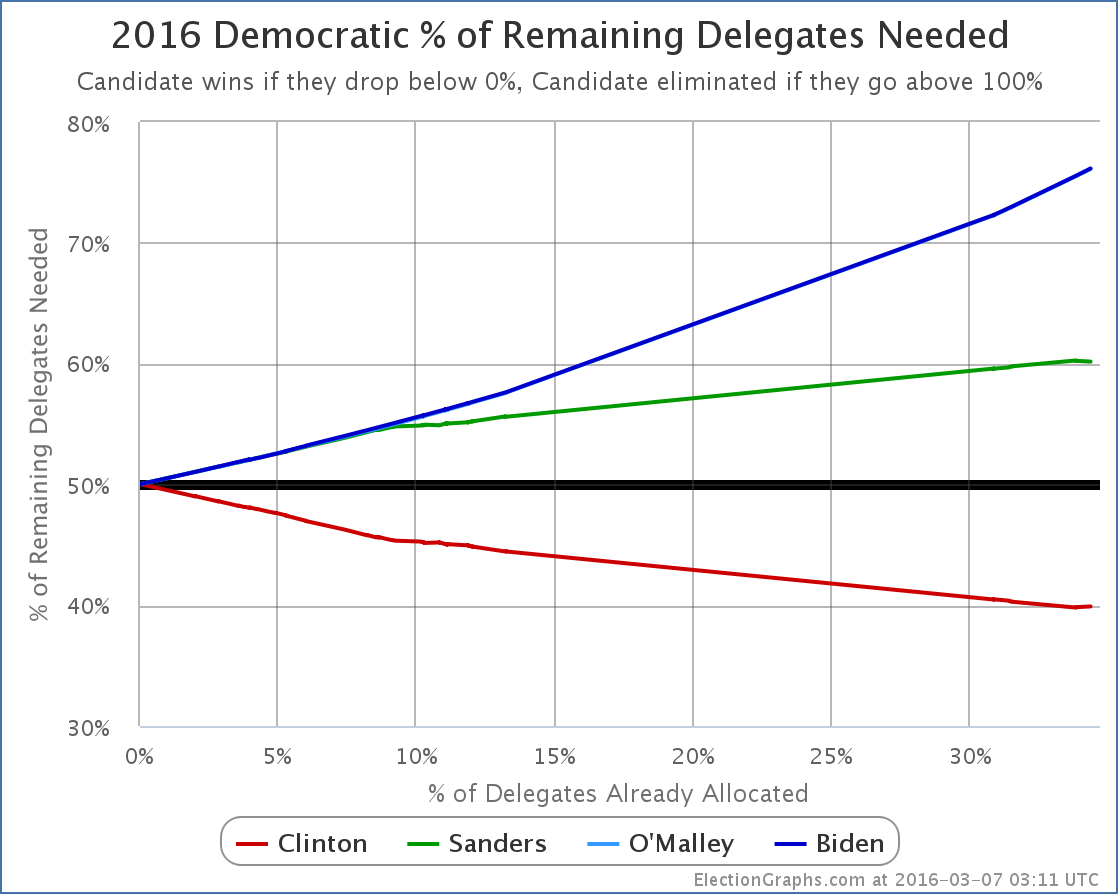
Yeah, see that little tiny change in direction at the ends of the green and red lines? That’s it.
Sanders did indeed improve his position in the race by winning Maine by a nice large margin. Yesterday he needed 60.26% of the remaining delegates to win. Today he needs… 60.17% of the remaining delegates.
Clinton of course also had a little setback. Instead of needing 39.80% of the remaining delegates, she now needs 39.90%.
Yeah, not much of a change, is it.
After the slight speed bump in Maine, Clinton’s march to the nomination continues…
Update 2016-03-09 03:19 UTC – Full superdelegate scan in preparation for adding new delegate results. Net Clinton +4, Sanders +3. Also 1 additional delegate added to the total number of delegates. This of course does not change the analysis above significantly.
Note: This post is an update based on the data on ElectionGraphs.com. Election Graphs tracks both a poll based estimate of the Electoral College and a numbers based look at the Delegate Races. All of the charts and graphs seen in this post are from that site. Additional graphs, charts and raw data can be found there. All charts above are clickable to go to the current version of the detail page the chart is from, which may contain more up to date information than the snapshots on this page, which were current as of the time of this post. Follow @ElectionGraphs on Twitter or like Election Graphs on Facebook to see announcements of updates or to join the conversation. For those interested in individual general election poll updates, follow @ElecCollPolls on Twitter for all the polls as they are added.
Absent something really surprising happening… which you never know… could happen… the posts on the Democratic side at this point are essentially just going to be documenting Clinton’s slow but sure march to the Democratic nomination.
On March 5th if you go by states, you would see Sanders winning Kansas and Nebraska, while Clinton only won Louisiana.
Of course, states don’t matter. Delegates do. For the night, Clinton got 59 delegates and Sanders got 50.
In addition, since the post about Super Tuesday there were adjustments for finalized Super Tuesday results and new superdelegate counts. The net result was that Clinton gained an additional 22 delegates while Sanders added 13.
So total since then… Clinton +81, Sanders +63.
At the time of that last post, Clinton needed 40.52% of the remaining delegates to be on track to win. Sanders needed 59.54%.
Actual percentages since then? Clinton 56.25%, Sanders 43.75%. Clearly Clinton easily exceeded her targets, while Sanders… did not.
Actual delegate counts right now: Clinton 1127, Sanders 482, O’Malley 1.
You need 2382 delegates to win. 1610 have already been counted. There are 3153 left to be determined.
Where does that put things now?
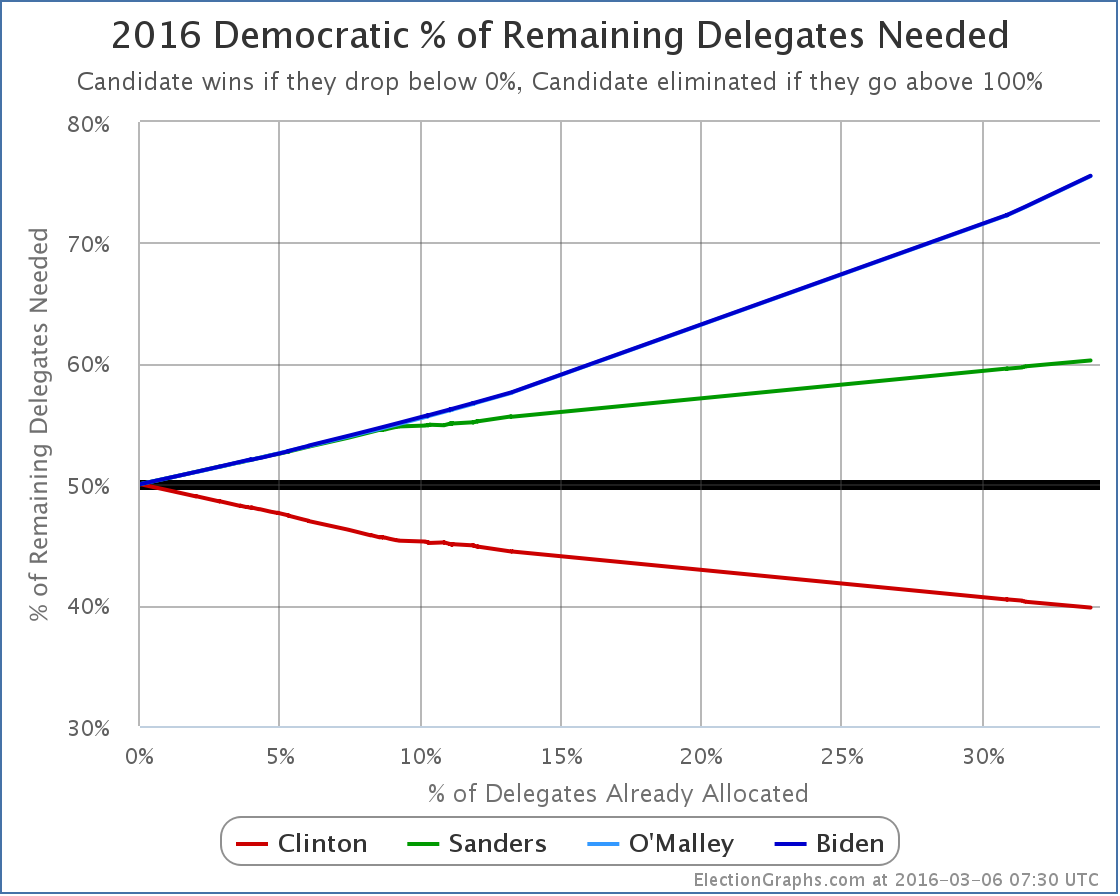
Clinton now needs only 39.80% of the remaining delegates to win.
To catch up and win, Sanders would need 60.26% of the remaining delegates.
Next up is Maine. I haven’t found any polling on Maine. It seems like it might be a good state for Sanders. But is it 60.26% good? In delegate terms that would be 16 of the 25 pledged delegates. Guess we’ll find out.
[Update 15:56 UTC: Overnight updates gave Sanders 1 additional delegate in Louisiana and Clinton 1 less. So if I’d waited until morning to post this the title would have said Clinton won 58 to 51 rather than 59 to 50. But the substance of the post remains the same.]
[Update 2016-03-07 03:07 UTC: Another update gives Sanders yet another delegate in Louisiana and Clinton yet another less. So Louisiana now Clinton 37 to Sanders 14, and March 5th contests overall Clinton 57 to Sanders 52.]
Note: This post is an update based on the data on ElectionGraphs.com. Election Graphs tracks both a poll based estimate of the Electoral College and a numbers based look at the Delegate Races. All of the charts and graphs seen in this post are from that site. Additional graphs, charts and raw data can be found there. All charts above are clickable to go to the current version of the detail page the chart is from, which may contain more up to date information than the snapshots on this page, which were current as of the time of this post. Follow @ElectionGraphs on Twitter or like Election Graphs on Facebook to see announcements of updates or to join the conversation. For those interested in individual general election poll updates, follow @ElecCollPolls on Twitter for all the polls as they are added.
Update 08:40 to add actual delegate counts, how many are left, etc.
On this week’s Curmudgeon’s Corner podcast Ivan and Sam start off talking about things OTHER than Election 2016. The upcoming small iPhone announcement, corporate reorgs, Kanye and The Pirate Bay, feedback on the show, and more! But of course then it is election time. They cover the Super Tuesday results in both parties, the Republican delegate math, the possibilities of a Republican schism, and everything else surrounding the race that they can think of.
Click below to listen or subscribe… then let us know your own thoughts!

Recorded 2016-03-03
Length this week – 1:59:20
 1-Click Subscribe in iTunes 1-Click Subscribe in iTunes
 View Podcast in iTunes View Podcast in iTunes
 View Raw Podcast Feed View Raw Podcast Feed
 Download MP3 File Download MP3 File
 Follow the podcast on Facebook Follow the podcast on Facebook
Show Details:
- (0:00:10-0:10:30) But First
- Agenda
- Small iPhone
- Mexico City
- Reorgs
- (0:11:50-0:42:03) Lightning Round
- Carillian prelude
- Apple wins a round
- Malaysian Plane
- Kanye and Pirate Bay
- Nearby House Fire
- North Korea
- Syria
- Feedback
- Sam’s Vote?
- (0:43:08-1:28:41) Election 2016 Part 1
- Democratic Super Tuesday Results
- Sanders lost, get over it
- Carson out
- Christie and Trump
- Rubio attacking Trump
- Trump’s Business Success
- Effect of Rubio’s Attacks?
- Trump Delegate Math
- Forcing a contested convention?
- Delegate Shenanagans
- Odds of President Trump?
- Trump’s Policy Details
- The Mexican Wall
- Trump and Duke/KKK
- (1:29:44-1:59:01) Election 2016 Part 2
- Never Trump Republicans
- Will the Republicans Split?
- Is Clinton more conservative than Trump?
- Trump’s Supporter’s Motivations
- Immigrant Debate
- Romney Attacks
- Trump’s Free Media
- Buying votes not working
- The Next Contests
Well, Super Tuesday is over except for a few straggling delegates that were not yet determined when it was time to start writing this post. So how did things end up? A lot of places will concentrate on “states won” and say that Clinton won 7 states and Sanders won 4. That’s well and good, but we’re going to look at what actually matters… the delegate totals.
First as a reminder, on Sunday I used current polling to predict where we would end up on delegates. Subtracting out “Delegates Abroad” which as it turns out won’t report results for a few more days, the polling suggested we would get results something like:
Estimate: 526 Clinton, 339 Sanders
And where are we actually? I’ll refrain from going through this state by state and just jump to the totals.
Actual: 504 Clinton, 335 Sanders, 26 TBD
The 26 TBD delegates are from Texas (19 delegates) and Tennessee (7 delegates). They could still split in such a way that the estimate ends up exactly correct. But even if it doesn’t, it will have been pretty close.
Bottom line is that the results are very closely in line with what would have been expected given the polling. No surprises here.
Where does that put our all important “% of remaining delegates needed to win” chart?
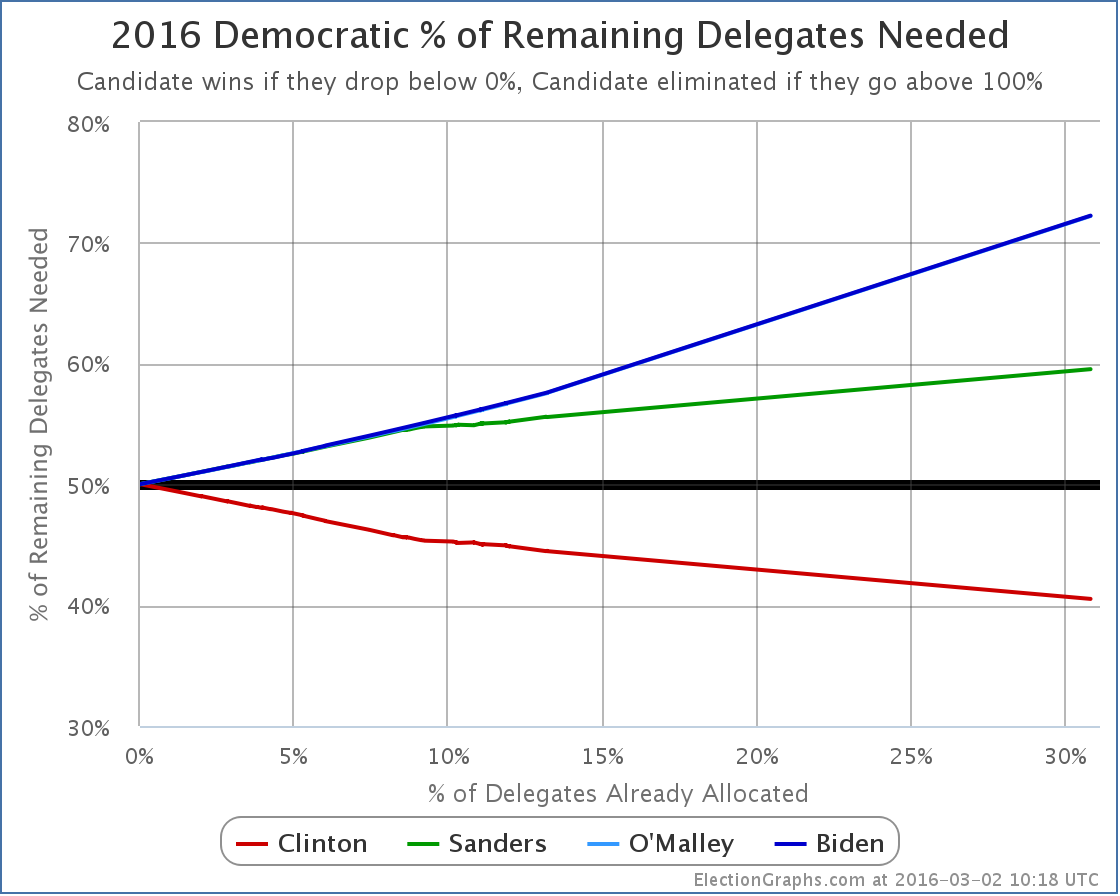
Clinton now only needs 40.52% of the remaining delegates to win the nomination. Sanders needs 59.54% of the remaining delegates to win.
Or of course large numbers of Clinton superdelegates have to start defecting to Sanders, which would raise Clinton’s number, and lower Sanders’ number. But there continues to be no sign of any such movement. And with Sanders continuing to lose the race for non-super delegates as well, it seems unlikely that a a big rush of “back the winner” movement will be heading Sanders’ way any time soon.
In the title of this post, I ask “what next?”. But even if Sanders had some “momentum” coming out of Super Tuesday (he really doesn’t) getting to 60% of the delegates in the coming contests would be a very tall order. His performance so far has been nowhere near that level. The Sanders folks may not be quite ready to admit it yet, but absent a Clinton implosion of historic proportions, the Sanders race for the nomination is over. If Sanders continues to fight on through the remaining contests, it isn’t to win, it is back to “making a point”, and “giving exposure to his issues”, and “moving the party towards him”, which was probably his original goal before he started doing a lot better than people originally expected. Those are legitimate reasons to continue a campaign. But it is not about winning the nomination.
What next? Clinton slowly but surely pushes her lead until she has 2,382 delegates and wins the nomination.
Before closing up, just a quick comparison:
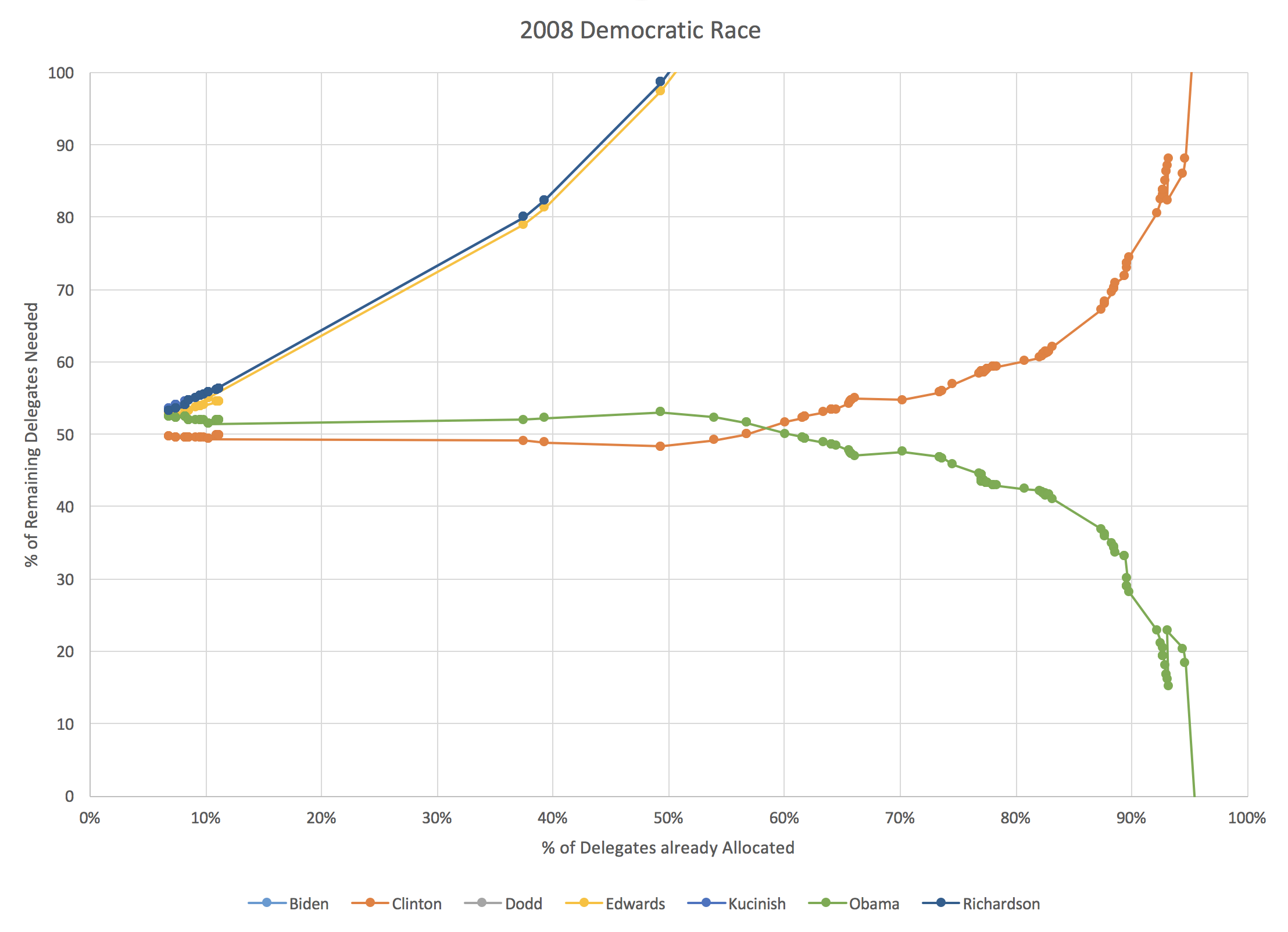
Although I didn’t produce the chart in exactly the same form when I did the analysis in 2008, a few minutes in Excel with the old data produced the equivalent chart for 2008. It is interesting to compare where we are.
First of all, at just over 30% of the delegates allocated, Clinton was still ahead in 2008! But it was much closer than things are today. She needed about 49% of the remaining delegates to win, compared to only needing about 41% today. Obama needed about 52% of the remaining delegates to catch up and win. Which he obviously did. At that point he already had about 47% of the delegates that were already allocated though… while Sanders only has about 29% of the delegates. (Both 2008 and 2016 numbers of course include superdelegates.) So while Obama was able to mount a come from behind win from this point in the delegate race, Sanders is far far behind where Obama was.
Sanders is now approximately where Clinton was when about 80% of the delegates had been determined. In 2008, that was in late April. The media was still talking about the Clinton/Obama race at that point, and hyping up increasingly outlandish scenarios where Clinton could still win, because a race is more interesting than having a clear winner, but anybody watching the numbers knew it was over at that point absent a catastrophic event.
In any case, back here in 2016, I will of course continue to watch the races and post updates after each contest. If a major event happens that changes everything and puts Sanders back on track to win you will see it here. Absent that though, we’re just going to be watching Clinton’s slow march toward mathematically clinching the nomination.
[Update 2016-03-03 02:17 UTC – Update on super Tuesday delegates. The 7 TBD delegates in Tennessee broke 6 for Clinton, 1 for Sanders. The 19 TBD delegates in Texas broke 12 for Sanders, 7 for Clinton. In addition in Minnesota the estimates were adjusted to give one less delegate to Sanders, and one more to Clinton. Net for this round of updates: Clinton +14, Sanders +12, bringing totals to Clinton 1060, Sanders 431, O’Malley 1. This does not substantively change the analysis above.]
[Update 2016-03-04 02:51 UTC – Superdelegate update: Net Clinton +2]
[Update 2016-03-05 16:41 UTC – Superdelegate update: Net Clinton +6]
[Update 2016-03-06 07:30 UTC – Final superdelegate update prior to results from March 6th states: Net Sanders +1]
Note: This post is an update based on the data on ElectionGraphs.com. Election Graphs tracks both a poll based estimate of the Electoral College and a numbers based look at the Delegate Races. All of the charts and graphs seen in this post are from that site. Additional graphs, charts and raw data can be found there. All charts above are clickable to go to the current version of the detail page the chart is from, which may contain more up to date information than the snapshots on this page, which were current as of the time of this post. Follow @ElectionGraphs on Twitter or like Election Graphs on Facebook to see announcements of updates or to join the conversation. For those interested in individual general election poll updates, follow @ElecCollPolls on Twitter for all the polls as they are added.
[Edit 16:44 UTC to actually answer the “What’s next?” from the title.]
As expected, Clinton easily won South Carolina. Clinton won 39 delegates, Sanders got 14.
Since my last post on the Democrats the tally has also added a net 10 superdelegates for Clinton, 1 for Sanders, and 1 straggler for O’Malley.
As of that last post, Sanders needed to get more than 55.03% of delegates to be on track to catch up with Clinton and win. Obviously that hasn’t happened with these updates. He got 23.08% of the delegates since that post.
So the end result is that the percentage of the remaining delegates Sanders needs to win goes up, while that number for Clinton goes down:
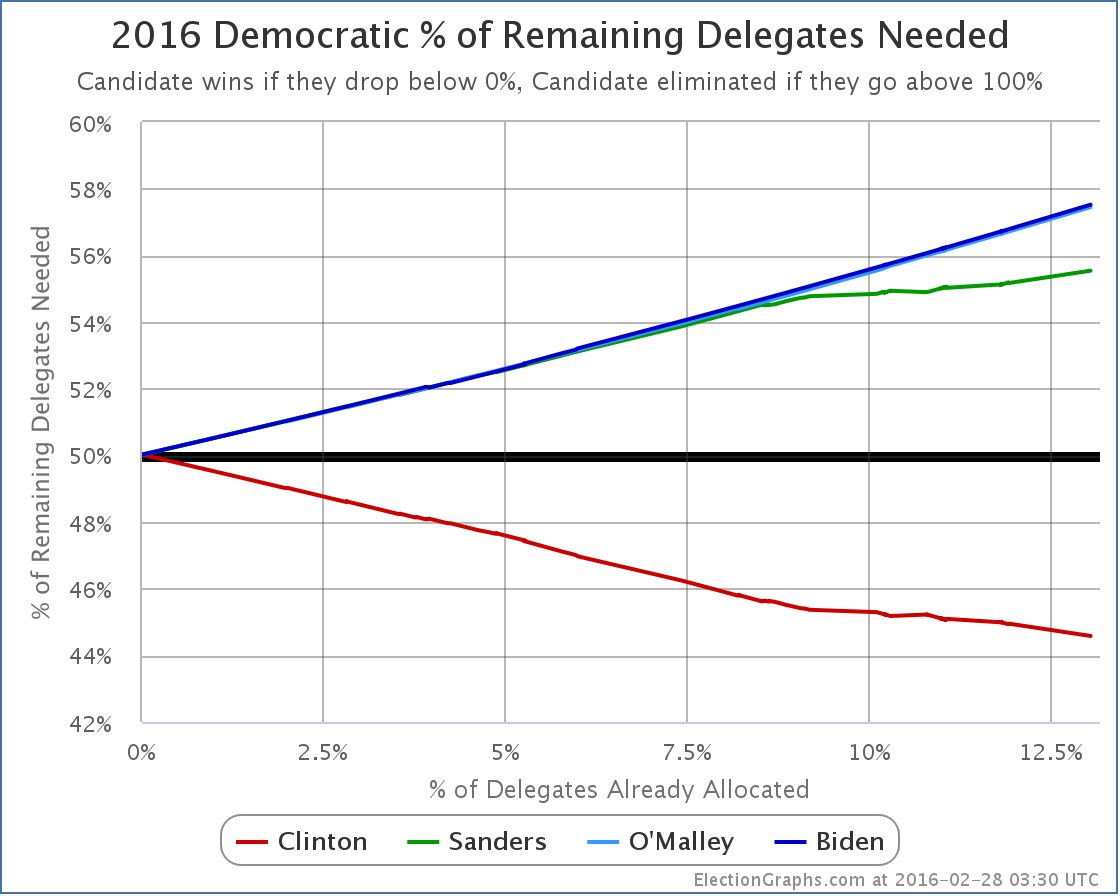
South Carolina is that slight acceleration of the curves starting at about 11.9%.
Sanders now needs 55.54% of the remaining delegates to catch up and win. (Or less if he starts flipping Clinton superdelegates to his side, but there has been no sign of that yet.)
Meanwhile, Clinton only needs 44.58% of the remaining delegates to win.
Frankly, in the 2008 and 2012 cycles once the frontrunner needed less than 45% of the delegates to win, it was time to start calling the race over. Yes, something happening that would allow a challenger to catch up and win is still possible. But it is unlikely. And with each additional contest where the challenger fails to make their own “% needed to win” mark, it gets harder.
But lets not consider it done quite yet. Super Tuesday is coming up in a few days. Maybe there is something there to indicate this isn’t over quite yet. Just as I did for the Republicans, lets game out what Super Tuesday looks like based on current polling. I’ll use the RCP poll averages, then try to estimate delegates based on the rules in each state.
Texas (222 delegates)
- Current poll averages: 59.9% Clinton, 33.6% Sanders
- Delegate estimates: 142 Clinton, 80 Sanders
Georgia (102 delegates)
- Current poll averages: 62.8% Clinton, 26.0% Sanders
- Delegate estimates: 72 Clinton, 30 Sanders
Virginia (95 delegates)
- Current poll averages: 54.5% Clinton, 35.0% Sanders
- Delegate estimates: 58 Clinton, 37 Sanders
Massachusetts (91 delegates)
- Current poll averages: 46.3% Sanders, 45.7% Clinton
- Delegate estimates: 46 Sanders, 45 Clinton
Minnesota (77 delegates)
- Current poll averages: 54.5% Clinton, 28.5% Sanders
- Delegate estimates: 51 Clinton, 26 Sanders
Tennessee (67 delegates)
- Current poll averages: 53.0% Clinton, 30.0% Sanders
- Delegate estimates: 43 Clinton, 24 Sanders
Colorado (66 delegates)
- Last poll from November so using national averages: 47.2% Clinton, 42.2% Sanders
- Delegate estimates: 35 Clinton, 31 Sanders
Alabama (53 delegates)
- Using only poll from February: 59% Clinton, 31% Sanders
- Delegate estimates: 35 Clinton, 18 Sanders
Oklahoma (38 delegates)
- Current poll averages: 45.0% Clinton, 36.0% Sanders
- Delegate estimates: 21 Clinton, 17 Sanders
Arkansas (32 delegates)
- Current poll averages: 57.0% Clinton, 28.5% Sanders
- Delegate estimates: 21 Clinton, 11 Sanders
Vermont (16 delegates)
- Current poll averages: 84.5% Sanders, 9.5% Clinton
- Delegate estimates: 16 Sanders
Democrats Abroad (13 delegates)
- No polls, using national averages: 47.2% Clinton, 42.2% Sanders
- Delegate estimates: 7 Clinton, 6 Sanders
American Samoa (6 delegates)
- No polls, using national averages: 47.2% Clinton, 42.2% Sanders
- Delegate estimates: 3 Clinton, 3 Sanders
OK. Adding all those up…
533 Clinton, 345 Sanders
Now, these are estimates based on relatively sparse polling and the assumption that candidate support is uniformly distributed within each state. The results will not be exactly like this.
But unless something major happens to change the picture in the next couple of days, the results on Tuesday should look broadly similar to this. With the estimate above, Sanders gets about 39.3% of the delegates. A far cry from the 55.5% he would need in order to actually improve his position against Clinton.
Adding the current delegates to the estimated Super Tuesday delegates, the new totals would be:
1,069 Clinton, 427 Sanders, 3 O’Malley
31.5% of the delegates will have been allocated. But 68.5% would still be available.
What would Sanders’ new “% of remaining needed to win” be at that point?
It would be 59.9%.
Sanders would need nearly 60% of the remaining delegates to catch up and win, or a massive defection of Clinton superdelegates to lower that number.
To imagine Sanders performing like this, you either have to believe the remaining states are vastly different in their preferences to the states that will have gone before (there is no evidence for this so far), or some massive seismic event would have to happen in the campaign to dramatically change minds of large numbers of Democratic voters in a very short timeframe.
A good argument could be made that absent a shocking surprise, this race is already done. After Super Tuesday, if the results are anything like the estimates above, then those hoping for a Sanders win will be grasping at the thinnest of straws. By the time we get to the end of March, again, absent that huge surprise, there will be no serious question any more.
Now, surprises do sometimes happen. You never know. But you don’t get to a Sanders win from here with just “normal” campaigning. It would take something bigger… a major Clinton scandal bigger than anything seen so far… a serious issue with Clinton’s health… something along those lines.
This doesn’t preclude Sanders staying in the race all the way until the convention and battling in every primary and caucus. He could do that if his cash flow holds out. But it would be to champion his issues and to try to move the party further in his direction, it would not be a serious attempt to win the nomination.
Three days from the time I post this, we’ll have Super Tuesday results and we’ll see just how close my poll based guestimates were and if this analysis holds up. More then…
[Update 2016-03-02 00:47 UTC – As a result of a final scan for superdelegates prior to adding Super Tuesday results we have a net change of +7 Clinton superdelegates, +2 Sanders superdelegates, -2 O’Malley superdelegates (they flipped to Clinton). This does not substantively change any of the analysis above and does not get a separate blog post, but a note here was warranted.]
Note: This post is an update based on the data on ElectionGraphs.com. Election Graphs tracks both a poll based estimate of the Electoral College and a numbers based look at the Delegate Races. All of the charts and graphs seen in this post are from that site. Additional graphs, charts and raw data can be found there. All charts above are clickable to go to the current version of the detail page the chart is from, which may contain more up to date information than the snapshots on this page, which were current as of the time of this post. Follow @ElectionGraphs on Twitter or like Election Graphs on Facebook to see announcements of updates or to join the conversation. For those interested in individual general election poll updates, follow @ElecCollPolls on Twitter for all the polls as they are added.
This week on Curmudgeon’s Corner Sam and Ivan of course talk about Election 2016, covering both the Democratic and Republican nomination races, then some speculation about what a Clinton vs Trump race may look like. Before that though, they spend some time following up on both the Apple vs FBI case and the SCOTUS vacancy. And there is some feedback to discuss!
Click below to listen or subscribe… then let us know your own thoughts!

Recorded 2016-02-25
Length this week – 1:32:14
 1-Click Subscribe in iTunes 1-Click Subscribe in iTunes
 View Podcast in iTunes View Podcast in iTunes
 View Raw Podcast Feed View Raw Podcast Feed
 Download MP3 File Download MP3 File
 Follow the podcast on Facebook Follow the podcast on Facebook
Show Details:
- (0:00:10-0:11:03) But First
- Water Heater Fire
- Commutes
- Agenda
- Feedback
- (0:12:07-0:28:20) Apple vs FBI
- PR Battle
- Cracking Safes
- Other ways to get info
- Test Case
- Slippery Slopes
- Lavabit comparison
- (0:29:06-0:42:09) SCOTUS and Congress
- Doing Nothing
- Republican Strategies
- Options in January
- Senate Implications
- Republican Factions
- Ivan for SCOTUS
- (0:42:48-1:01:36) Election 2016 – Primaries
- Ivan for SCOTUS continued
- Clinton Still Winning
- Judicial Murders
- Trump SC/NV Wins
- Dissipating Trump Denial
- Gaming out Super Tuesday
- (1:02:16-1:31:53) Election 2016 – Clinton vs Trump
- Trump as third party after contested convention?
- Are there really that many asshole racists?
- The whiteness of the GOP
- Clinton vs Trump personal attacks
- Trump attacking from both Right and Left
- Trump Reinvention
- President Trump
Sanders needed to win 20 of the 35 delegates available in Nevada’s caucuses to be on a pace to catch up with Clinton and win the Democratic nomination. He did not get 20. He got 15. Clinton got 20. There was some talk from the Sanders camp about how much closer Nevada was than it looked like it would be a few weeks ago. That is true. But in the end, the result is Clinton getting 57% of the delegates while Sanders gets 42%.
So Sanders falls further behind. Lets look at the charts.
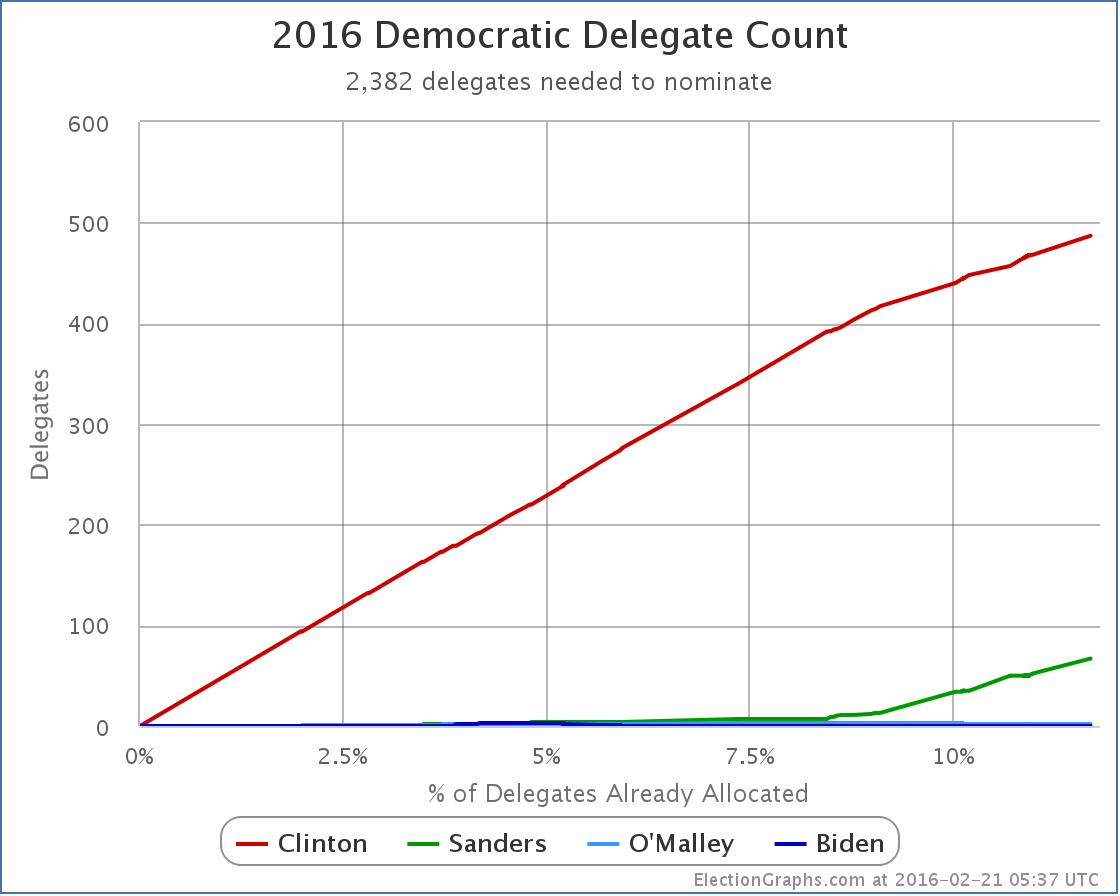
First the straight up delegate counts. We are now at Clinton 487, Sanders 67, O’Malley 2.
In addition to the delegates from the Nevada caucuses, since my last update on the 14th when 42 superdelegates were added for Clinton there have been other updates contributing to those numbers. That includes a number of new delegates identified as being for a candidate, a couple delegates who had been identified as being for a candidate saying explicitly that they considered themselves to be neutral, a few double counting errors corrected, and even one superdelegate dying. The net result was 6 more delegates for Clinton and 2 more for Sanders. And I gave O’Malley back 2 superdelegates who despite his dropping out have not yet stated another preference. In general these changes are backdated to the date there is evidence for them, rather than being dated as of the time I find the change.
Add those all up, and since New Hampshire, Clinton’s total has increased by 68 delegates while Sanders gained 17. If you don’t count the delegates that changed before New Hampshire that I found out about after New Hampshire, it is still 30 Clinton delegates to 17 for Sanders.
Either way, Clinton continues to accumulate delegates faster than Sanders does. That is not a recipe for Sanders catching up. To catch up, Sanders needs to either be getting supermajorities of the delegates from primaries, caucuses and currently unpledged superdelegates, or he needs to be getting quite a few current Clinton superdelegates to defect. So far neither of those things have been happening.
(Note: AP and CNN have Clinton’s delegate totals even higher, presumably due to some non-public superdelegate commitments they know about but haven’t published. The above counts are mostly using superdelegate counts from Wikipedia except for a handful of cases where I have deviated for specific reasons where I believe I have a better count.)
So, how is the “% of remaining delegates needed to win” looking?
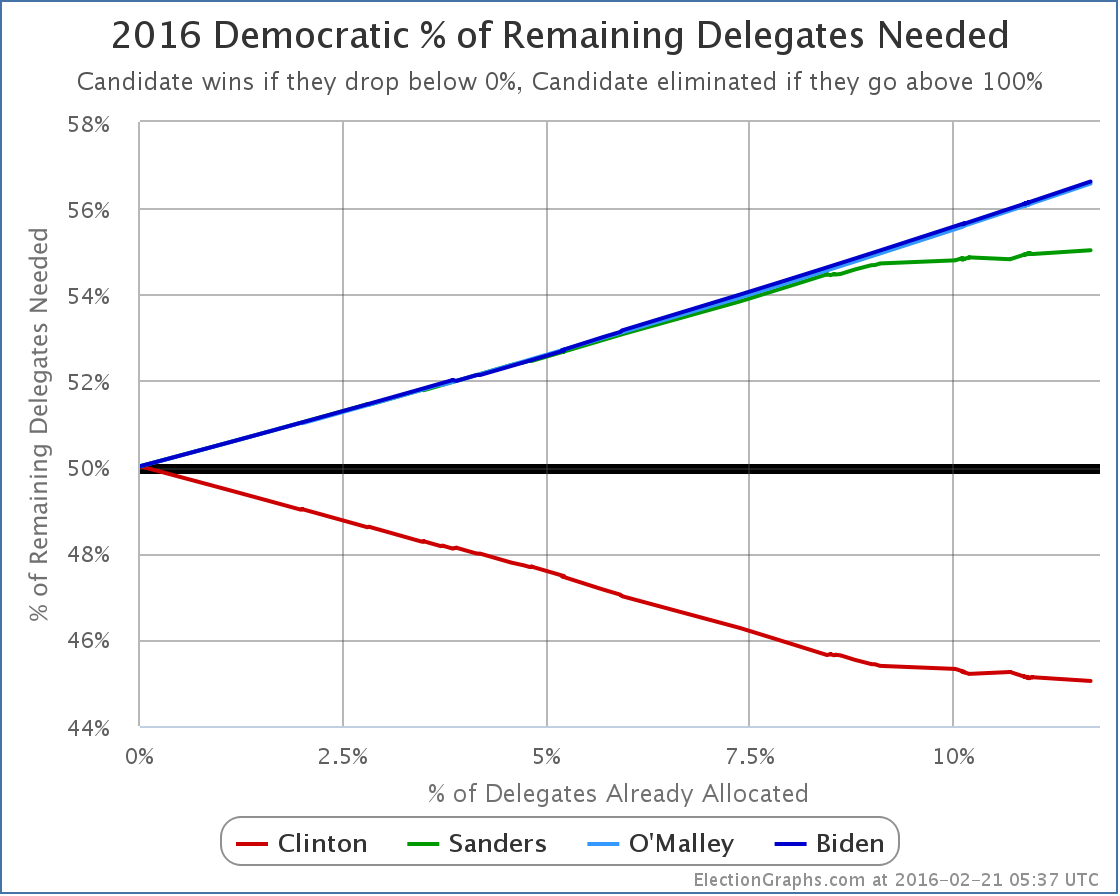
Since Sanders has not been making his percentages, and Clinton has, Clinton’s line is slowly dropping, and Sanders’ is slowly rising. Slowly is the watchword here though. Sanders is now up to 55.03%. Right before Iowa, this was at 54.22%. (Counting the postdated delegates, 54.72%.) Sanders hasn’t done well enough that he is actually catching up with Clinton, but he has done well enough to keep the movement on this number low. He is ALMOST keeping Clinton from making progress. Almost but not quite.
As more delegates get racked up, assuming Sanders continues to collect less than 55% of the delegates, it will not only get harder and harder to catch up to Clinton, it will also get harder and harder to prevent that red line from zooming downward to zero, the point where Clinton wraps up the nomination.
For now though, while he isn’t stopping her, Sanders is clearly slowing Clinton down more than she would like.
Next up, South Carolina.
Update 2016-02-26 15:55 UTC – Completed a scan for superdelegate changes. Net result is +6 Clinton superdelegates… plus one new O’Malley superdelegate. This is not actually a NEW O’Malley superdelegate, but one that declared their support back in November but just hadn’t been logged yet, and there is not yet evidence of them stating they are now uncommitted or backing another candidate. These changes have no substantive effect on the analysis above.
Update 2016-02-28 03:24 UTC – Another scan for superdelegates in preparation for adding in South Carolina results. Net result Clinton +4, Sanders +1. This again has not substantive effect on the analysis above, but putting a note here since it is not worth a blog post of its own.
Note: This post is an update based on the data on ElectionGraphs.com. Election Graphs tracks both a poll based estimate of the Electoral College and a numbers based look at the Delegate Races. All of the charts and graphs seen in this post are from that site. Additional graphs, charts and raw data can be found there. All charts above are clickable to go to the current version of the detail page the chart is from, which may contain more up to date information than the snapshots on this page, which were current as of the time of this post. Follow @ElectionGraphs on Twitter or like Election Graphs on Facebook to see announcements of updates or to join the conversation. For those interested in individual general election poll updates, follow @ElecCollPolls on Twitter for all the polls as they are added.
Edit 17:17 UTC to add note about AP and CNN delegate counts.
On this week’s Curmudgeon’s Corner podcast Sam and Ivan do indeed talk a lot about Election 2016 and all of the developments there, but there is other news this week too! So first off is a discussion of Apple vs the FBI, then an analysis of the battle following Justice Scalia’s death. Oh, and you get the story of Sam’s drive from Seattle to San Francisco, and a bit about the limitations of video streaming too!
Click below to listen or subscribe… then let us know your own thoughts!

Recorded 2016-02-19
Length this week – 2:16:56
 1-Click Subscribe in iTunes 1-Click Subscribe in iTunes
 View Podcast in iTunes View Podcast in iTunes
 View Raw Podcast Feed View Raw Podcast Feed
 Download MP3 File Download MP3 File
 Follow the podcast on Facebook Follow the podcast on Facebook
Show Details:
- (0:00:10-0:31:57) But First
- Sam in a Hotel
- Agenda
- New Microphone
- Internet Quality
- Sam’s Drive
- (0:32:37-0:54:55) Apple vs FBI
- The Order
- Why Apple Refused
- Why is FBI pushing this case?
- What if Apple loses?
- What if Apple wins?
- Industry Implications
- Slippery Slope
- Politicians and Encryption
- (0:55:58-1:21:14) Death of Justice Scalia
- Ivan’s doppelgГ¤nger
- The news breaks, people go nuts
- Republican Senate says don’t even nominate
- Higher stakes that previous vacancies?
- Recess Appointment?
- Does this damage Senate Republicans?
- Who does Obama pick?
- Hypocrisy?
- Will the wall hold until January?
- Impact of 4-4 Court
- (1:22:34-1:40:01) Election 2016 – Democrats
- Upcoming Contest Schedule
- Nevada Polls
- Election Graphs Comment
- Superdelegates
- Possible paths for Sanders
- (1:40:50-2:08:09) Election 2016 – Republicans
- The Latest Debate
- Polling Update
- Gaming out the next states
- Trump trying to lose?
- Trump lawsuit threats
- Trump’s RNC Deal
- Trump and the Pope
- (2:09:18-2:16:36) Lightning Round
- Obama going to Cuba
- Steaming Video
Since the New Hampshire primary, I have seen a flurry of Facebook posts and numerous articles all over the place, first by people suddenly shocked to learn of the existence of superdelegates, then folks complaining about the DNC “screwing over” Sanders, and then folks claiming superdelegates should be ignored because they don’t matter. All this in response to places, like my site electiongraphs.com, that point out Clinton’s huge lead due to superdelegate counts.
My current chart of raw delegate totals looks like this:
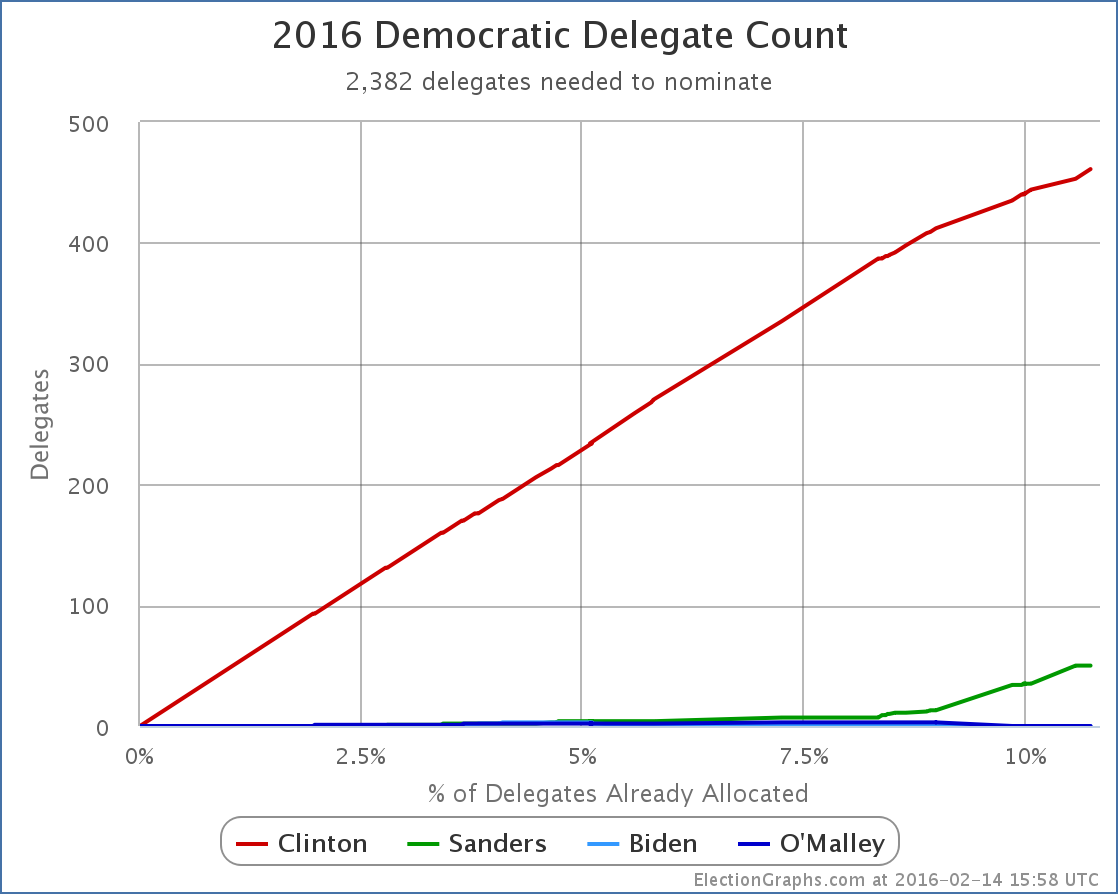
That is Clinton 461 to Sanders 50 including the latest updates that prompt this post.
The claim is that the Clinton lead here is a complete illusion. That counts that look like this are simply anti-Sanders propaganda meant to discourage Sanders voters, that looking at numbers like this is meaningless, and one should only look at “pledged” delegates, where the total right now would be Sanders 36, Clinton 32. That would indeed show a very different picture of the race. Sanders would actually be winning!
But really? Would that tell us where the race really is?
First of all, there isn’t any secret or underhanded manipulation. There are 32 delegates in New Hampshire. 24 of them were to be determined by the primary. Of these Sanders won 15 and Clinton won 9. Some of those are determined proportionately in each congressional district, some proportionately by the statewide results. Those numbers come straight from the votes. Just math.
Then there were also 8 “super delegates”. That is one Senator, one Representative, one Governor, and five members of the DNC. These are eight people who have names and have been known for ages. Six of those eight had declared they supported Clinton long before the primary. The other two haven’t publicly stated a preference yet. That means the delegate total in New Hampshire is now 15 to 15 with 2 not yet determined.
The Sanders folks might not like that, or like the existence of super delegates at all, but none of this is new or an unexpected manipulation or anything, it is simply how the race is structured. A lot of people are expressing shock because they are just now realizing this, but it is no surprise to anyone familiar with the Democratic primary process, and certainly Sanders’ campaign staff is quite familiar with it.
As we’ve chronicled here, Clinton started out with nearly 8% of the national convention delegates already in her column before the first votes were even cast in Iowa and New Hampshire. She has been working on cultivating those people since at least 2013, probably earlier. Sanders managed to get a handful of these folks, but not many. So he started out way behind, and had to get over 54% of the remaining delegates to be on a pace to catch up and win. A majority wasn’t good enough.
It isn’t a good spot to be in for him, and you might argue that super delegates shouldn’t exist. Yes, superdelegates were originally created and exist to give the party apparatus some buffer against a popularly supported insurgency, and that sounds like Sanders. But the superdelegates have existed for decades and they are a known part of the process.
So complaining about them at this point is along the same lines as complaining about the electoral college. The person complaining might be right that in some ways a straight popular vote would be more “fair”, but these were the rules of the game and anybody running knew the rules when they chose to play.
It wasn’t superdelegates specifically that made the difference, but remember that in 2008, Hillary Clinton won the popular vote in the Democratic primary process.* It was only the structure of the delegate race that won Obama the nomination. Because those were the rules of the game. That is still the case today. And that includes superdelegates.
OK, fine, but what about the fact that super-delegates can change their minds? Their votes aren’t locked in stone, and they certainly wouldn’t want to overturn the results if a candidate was winning all the contests and had a majority of the non-super delegates, right? So since they can change their minds and will probably support “the winner” we should ignore them, right?
Indeed, it is important to note that the super-delegates are real people and complete free agents. They can and do change their minds. And yes, superdelegates may be reluctant to be the deciding factor in a close race, but you can’t really say “the super delegates would do X”. It is 712 individual humans, who will each decide on their own what they want to do.
Many superdelegates have yet to express a preference at all and can probably be fairly easily swayed. They have not expressed an opinion for a reason, and may well go either way. Others have publicly supported Clinton, but it could be weak support and maybe they could be flipped if they were actually courted. Many others are actually actively working on the Clinton campaign in prominent state level roles. People in this last category are unlikely to change their votes unless or until Clinton herself drops out and asks them to. At the very extreme, Bill Clinton is a superdelegate. Is he going to vote for Sanders?
You really do have 712 different people, with 712 different reasons for their preferences, and 712 different degrees of how strongly they support their candidate.
If Sanders was serious about the superdelegates, he and his surrogates wouldn’t be pushing talking points about how superdelegates don’t matter and will vote for the popular winner so they should be ignored. Instead he would be heavily lobbying the currently uncommitted superdelegates to start backing him. They are a constituency to be courted. They are an IMPORTANT constituency to be courted.
If you were to see such movement, the first place you would detect it would probably be a higher percentage of currently uncommitted superdelegates raising their hands for Sanders when they do come out and reveal a preference.
Superdelegates who have already publicly stated they are supporting Clinton will probably not start actually flipping back to uncommitted or to Sanders until or unless things are actually looking very dire for Clinton.
If you do end up seeing Sanders winning more contests than he loses and building up a big lead in the regular non-super delegates, you may start to see both kinds of movement. After all, people like backing a winner. But if it happens, you will actually see that change happening in the delegate counts if you watch this site or one of the other places that include superdelegates in the totals. It will not be invisible.
There is no sign of any such movement yet.
Can Sanders win without flipping any Clinton superdelegates over to his side? Yes, of course he can. It is a high bar, but it is within the realm of possibility. He just needs to get about 55% of the remaining delegates.
Can Sanders win with even a smaller portion of the remaining delegates? Why yes, of course he can, if he starts convincing Clinton delegates to change their minds. But if that is going to happen, they have to actually be convinced to do so. Here is a list. Go start lobbying them. Try to change their minds. But nobody should be assuming that is automatic.
Yes, if Sanders ends up leading the non-superdelegate count at the end of the primary season and superdelegates are the only thing putting Clinton over the edge, there will be extreme pressure on the superdelegates to flip. But they still have to actually do so. And most likely, when they start waffling on their positions, they will actually say so, and we will know.
The delegate counts including superdelegates are NOT misleading. You just have to interpret them correctly… meaning that you know superdelegates are actual human beings that can change their minds, and you think about what situations might lead that to happen. But ignoring that they exist and just assuming that of course they will change their minds is extreme folly. It is sticking your head in the sand and ignoring reality. It is willfully blinding yourself in order to believe in an illusion instead. If and when the superdelegates start changing their minds, we will see it. Until or unless that happens, Clinton really does have a huge delegate lead that Sanders would have to overcome in order to win.
Meanwhile, as the Sanders camp has been complaining about superdelegates and how they don’t matter, superdelegate movement to Clinton has continued. Since the New Hampshire Primary results, I’ve added 44 additional superdelegates to Clinton’s column. Not all of these actually announced their support this last week, some did so months ago, but I just found the references more recently. Their support gets backdated in the charts and graphs to the date of the public source documenting their support. I also removed 2 Clinton superdelegates that had been accidentlly double counted. Net gain, Clinton +42.
There were no new Sanders superdelegates.
So where does that put us on “% of remaining delegates needed to win”?
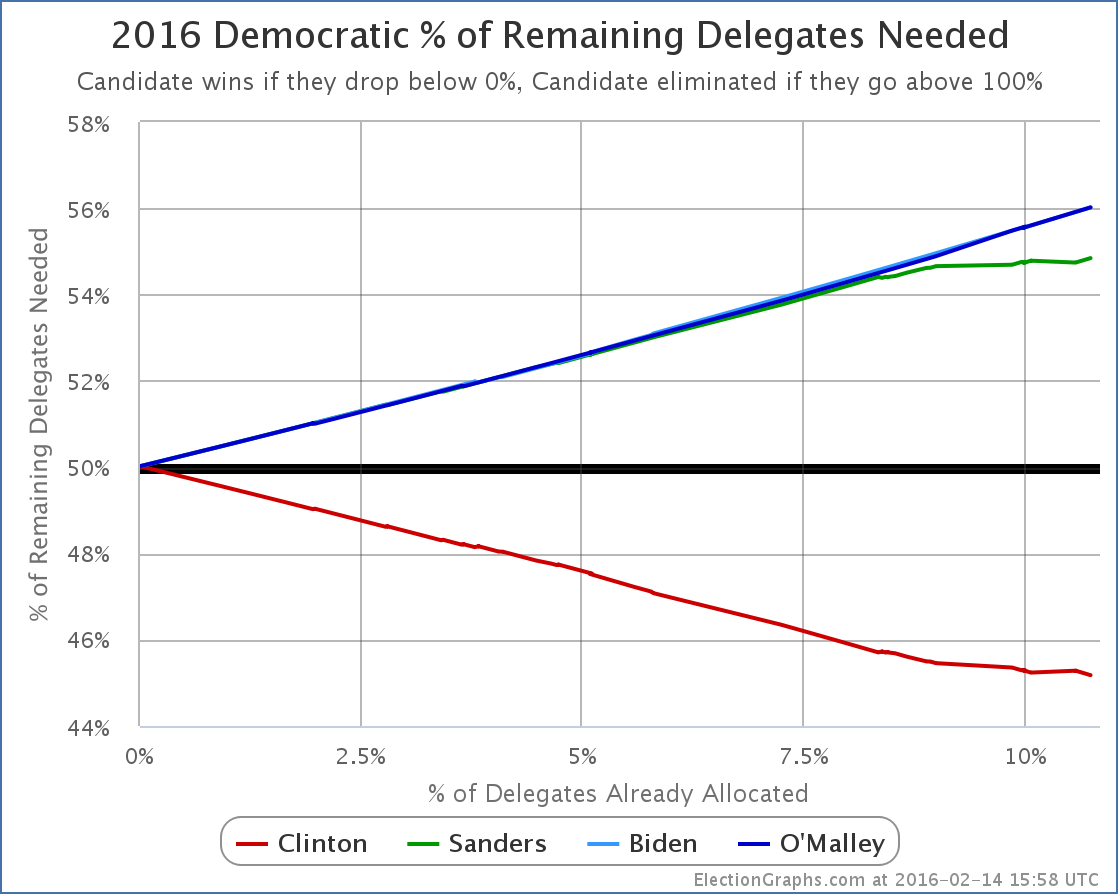
Clinton now needs only 45.18% of the remaining delegates to win.
Sanders needs 54.84%. Right before the Iowa caucuses, my best estimates were that sanders needed 54.22%. (Including pre-Iowa superdelegate preferences I know about now that weren’t included at the time, it would have been 54.65%.) So despite his close second in Iowa, and his win in New Hampshire, Sanders is worse off in the delegate race than he was before Iowa. But not by much… he has ALMOST been holding things steady. He needs to do better to catch up and win, but Iowa and New Hampshire are only a small portion of the overall delegates, so there is still a lot of room to maneuver.
The next delegate race is Nevada.
There are 35 delegates up for grabs in Nevada that will be determined by the caucuses there. Plus 8 superdelegates. Of these, 3 have already said they are for Clinton, and 1 has said they are for Sanders. So don’t be surprised when you see those added in at places showing the state delegate count. They aren’t part of the 35 determined by the caucus though.
Of the 35, Sanders needs to get 20 in order to be on a pace to catch up with Clinton. (Again, assuming no superdelegates change their minds, if a lot do, this number becomes lower.) The RCP average has Nevada at Clinton 47.5%, Sanders 36.0%. That certainly wouldn’t get Sanders the 20 delegates he needs, but that average only includes one post-New Hampshire poll, and that new poll shows the race tied. The Pollster average discounts the pre-New Hampshire results entirely and shows the race at 45% to 45%… a tie.
Delegate rules are tricky. In Nevada some delegates are determined at the congressional district level, others at the state level, there is rounding involved, etc, etc. It is also a multi-stage caucus process, not a primary, so the “real” delegate totals won’t be known until May. But we will have estimates.
Remember though that it is not that Sanders needs 54.84% of the popular vote. It is that he needs 20 of the 35 delegates. That is the number to watch.
And superdelegates of course. :-)
A final thought: It is very possible to catch up from a deficit. But catching up is much harder if you pretend you aren’t actually behind.
* It has been pointed out to me that this would likely not have been the case if Obama had, like Clinton, chosen to compete in Michigan despite DNC sanctions… Clinton essentially ran unopposed in Michigan and this margin was enough to put her in the lead in the national popular vote. If you do not include Michigan, Obama lead the popular vote in 2008. This does not however change the point, which was that there are many ways that the delegate rules can lead to results that differ from the popular vote, of which the superdelegates are only one.
Note: This post is an update based on the data on ElectionGraphs.com. Election Graphs tracks both a poll based estimate of the Electoral College and a numbers based look at the Delegate Races. All of the charts and graphs seen in this post are from that site. Additional graphs, charts and raw data can be found there. All charts above are clickable to go to the current version of the detail page the chart is from, which may contain more up to date information than the snapshots on this page, which were current as of the time of this post. Follow @ElectionGraphs on Twitter or like Election Graphs on Facebook to see announcements of updates or to join the conversation. For those interested in individual general election poll updates, follow @ElecCollPolls on Twitter for all the polls as they are added.
[Edit 18:06 to add link to Wikipedia superdelegate list.]
[Edit 18:48 to add final thought.]
[Edit 2016-02-16 06:50 UTC to add asterisk note about Michigan.]
|
|











